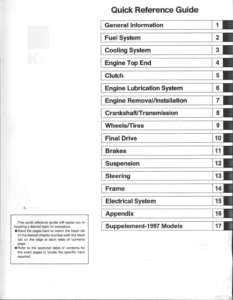Complete PDF version of the Service Manual for the Kawasaki Ninja ZX9R-B1-B4. A MUST for every Ninja ZX9R owner.
Download: Immediately after payment!
OEM Original factory workshop manual.
Models covered by this manual: 1994 to 1997
Number of pages: 322 pages
Table of contents:

This PDF repair manual can be downloaded right after the payment process in complete, on the device of your choice.
We do not offer printed manuals, for the following reasons:
- it is more eco-friendly to use a digital version
- your manual never gets dirty or greasy
- you can always choose to print the specific page(s) you need to work on your bike
- you receive your manual immediately after payment
- it is searchable
Kawasaki Ninja ZX9R
In reaction to Honda’s release of the CBR900RR Fireblade for the 1992 model year, Kawasaki created the Ninja ZX-9R model. Large-capacity Japanese sporting bikes had been polarized before to the introduction of the Fireblade. On one side, there were the 750cc sport bikes, which were influenced by Endurance racing and the World Superbike Championship. On the other hand, the “big-bore” 1,000 cc-plus sports-tourers had evolved naturally from the performance bikes of the previous 20 years.
In a nutshell, the 750s had the handling, while the big-bores had the power. Kawasaki dominated in both categories. The ZXR750 offered the technology and performance of ultra-expensive racing-homologation models from Honda and Yamaha for half the price, and it outperformed the similarly priced GSX-R750 of the time, which still featured a perimeter frame and an oil-cooled engine, while the ZZ-R1100 was the fastest production motorcycle on the planet.
The Fireblade was built around a 900cc engine and a 750cc sport bike frame. It blended big-bore power with sport bike maneuverability, but more importantly, it was the first to pay close attention to weight-saving design. The Fireblade not only outperformed the 750s in terms of power, but it was also substantially lighter. When Kawasaki set out to construct their Fireblade-beater, they ignored or underrated this feature. Rather than commit to an altogether new design, Kawasaki blended their class-leading big-bore, the ZZR1100, with their class-leading 750, the ZXR750, to create the first ZX-9R.
The result was a large motorbike; despite weight-saving techniques like as magnesium engine covers, its claimed dry weight was 215 kg (474 lb), over 30 kg (66 lb) more than the Fireblade. It produced roughly 125 horsepower (93 kW), which was between 10 and 15 hp (11 kW) more than the Fireblade, but this power advantage did not compensate for its size, weight, and inferior agility. Instead of being a direct competition, the ZX-9R was kept as a more stable and pleasant alternative to the Honda, with higher straight-line speed. The higher clipons and more upright sitting placements indicate a road-going orientation.
Models history
ZX900B (1994) and ZX900B2 (1995)
The original ZX-9R might be thought of as a ZXR750 with ZZ-R1100 design elements. The wheels (3.5-inch x 17-inch front and 5.5-inch x 17-inch rear), front forks (completely adjustable 43 mm upside-down KYB), and unbraced fabricated aluminium box-section swingarm with fully adjustable remote-reservoir KYB monoshock were all straight carryovers from the ZXR. The twin-piston rear Tokico caliper is no longer attached via a torque arm, and the clip-on handlebars are located above, rather than below, the top triple clamp. The ZZ-R and ZXR shared four-piston Tokico front calipers and 320 mm front discs.
Like the ZZ-R1100, the frame was a welded aluminum-alloy dual-beam with cast steering head and swingarm endplates, but with steel-tube engine cradles and swingarm-mount endplates extending back to support the rider’s seat and attach the bolt-on subframe.
The engine had a displacement of 899 cc. The crankcases, clutch, and gearbox were carried over from the ZXR750, but with a longer-throw crank and a larger-bore, taller cylinder block to accommodate the increased capacity. The cylinder head was outwardly quite similar to the ZXR, however it used rocker valve actuation like the ZZ-R1100 instead of direct actuation like the ZXR. Redline was 12,000 rpm vs 10,500 rpm for the Fireblades. The engine breathed through a 10-litre airbox supplied by dual ram-air intakes on the nose of the bike, beneath the single headlight, through ducts flowing back and over the frame beams near the steering head, similar to the ZZ-R.
ZX900B3 (1996) and ZX900B4 (1997)
Changes in the details. The power was raised from 139 to 141 horsepower (105 kW). The rear suspension linkage and spring rate were modified, resulting in improved handling. Pillion grab rails were added, the gearboxes were strengthened, and new six-piston Tokico front calipers replaced the four-piston units from the previous model. The bike’s weight climbed to 241.7 kg (533 lb).
Source: Wikipedia


